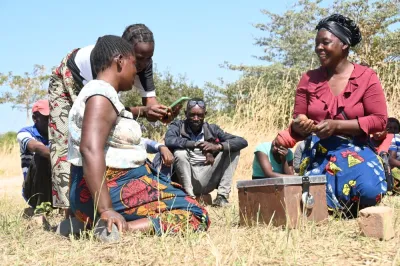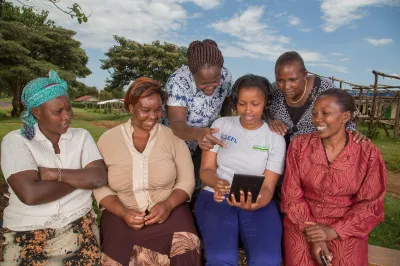Building a Shared Understanding of Financial Abuse: What Have We Learned So Far?

Since we published our last blog calling for action to address financial abuse, interest in the critical topic within the FinEquity community has steadily grown. Through ongoing discussions and collaborative efforts, our collective understanding of this often-overlooked form of abuse has deepened.
Several FinEquity members have been contributing to the broader dialogue by sharing valuable insights with the sector. For example, the Grameen Foundation has been unpacking various aspects of financial abuse based on existing research through a blog series. Another recent blog highlighted lessons from the Smart Campaign, which successfully mobilized industry-wide support for client protection—offering relevant insights on how this can be replicated for tackling financial abuse today.
To support exchange within the community of practice, last spring FinEquity facilitated a working group of 30 participants committed to exploring the complexities of financial abuse and the role financial service providers (FSPs) should play in combating it. While many questions remain, a clear takeaway is the need for more evidence to understand the lived experiences of survivors and the implications of financial abuse for financial institutions. This evidence could help shape strategies to both prevent and respond to financial abuse.
Defining financial abuse: the role of context and intersectionality
The working group explored existing definitions of financial abuse — Development of the Scale of Economic Abuse, Violence Against Women, Understanding the Economics of Abuse: An Assessment of the Economic Abuse Definition Within the Domestic Abuse Bill, and Understanding Economic and Financial Abuse in Intimate Partner Relationships — and developed an adapted definition for the financial inclusion sector. It defines financial abuse as, “a set of behaviors aimed at controlling an individual’s ability to acquire, use, or maintain financial resources, ultimately undermining their financial security and independence.” While financial abuse affects various vulnerable groups, the working group’s focus is on women and girls, particularly in the context of intimate partner violence and domestic abuse.
Here, financial abuse can take many forms—restricting access to, exploiting, or even sabotaging women’s financial resources. It may involve coercively preventing women from accessing financial information and services or using financial products (like joint accounts or loans) to control them. FSPs are uniquely positioned to mitigate these risks by embedding safeguards throughout the customer journey, from product design to service delivery.
Addressing financial abuse is not straightforward, given its intersections with socio-cultural norms, stages of life, employment status, and economic rights. These factors add layers of complexity that need to be understood and accounted for by FSPs to ensure effective prevention and response strategies.
Financial abuse is a risk for FSPs
Financial abuse is not just a social issue; it presents real financial risks for FSPs including credit, reputational, operational, and compliance risks. Misused financial products can lead to loan defaults, know-your-customer (KYC) violations, and damage to both clients and the institution’s reputation. Addressing these risks is a business imperative.
For FSPs, the starting point is to understand financial abuse within their operating context. Listening to survivors and staff helps unpack how financial abuse manifests and the role financial products can play—both in enabling and preventing abuse. Survivor-centric, trauma-informed approaches built on respect and confidentiality are essential to this effort.
Addressing abuse is an opportunity to better serve women
Taking steps to address financial abuse offers FSPs a valuable opportunity to deepen their understanding of the challenges women face in accessing and using financial services. By applying a financial abuse lens, FSPs can better identify barriers that prevent women from fully utilizing financial services. This understanding paves the way for developing gender-responsive products that not only protect women from harm but also enhance trust and expand access to underserved segments.
Leveraging existing systems to address financial abuse
Addressing financial abuse requires interventions throughout the customer journey, from identifying and preventing abuse to responding, supporting recovery, and monitoring—like a continuous feedback loop. These actions can range from minimum "do-no-harm" safeguards to proactive measures that support at-risk clients with tailored products and services.
A common concern is how FSPs can do this without taking on significant operational or compliance burdens. The solution may lie in leveraging existing systems, such as client protection frameworks, customer feedback channels, helplines, and monitoring mechanisms. Incorporating financial abuse awareness into staff training and client communication can be an effective step.
An ecosystem approach: collective responsibility
Finally, it’s critical to recognize that the financial sector cannot address financial abuse alone. A collective effort is required, involving civil society organizations that support survivors of gender-based violence, as well as governments, donors, and investors who champion women’s financial inclusion and economic empowerment. Engaging communities—both men and women—is essential to ensure that harmful norms are challenged. Only through collaboration can we create financial systems that are not only safer and more inclusive but also contribute to the true empowerment of women.
We invite you to join the conversation at the Financial Inclusion Week panel discussion on “Understanding Financial Abuse: Why the Financial Sector Should Care” on Friday, October 18th, at 5:45 AM EST. During the session, we will explore initial lessons from Grameen Foundation’s SAFE Program and IFC’s Empower Finance, and discuss how financial abuse fits within the client protection principles of SPTF+Cerise. Don’t forget to register and participate. Join the discussion!


